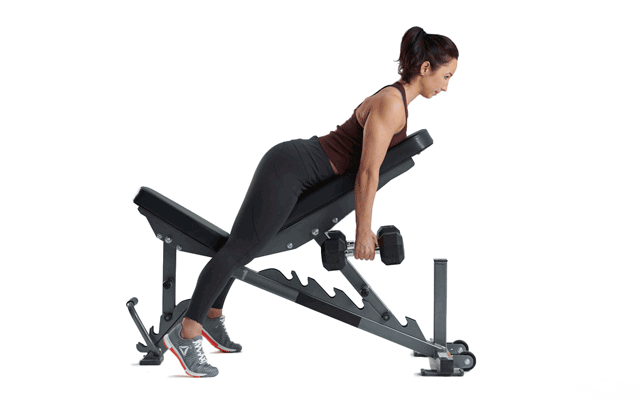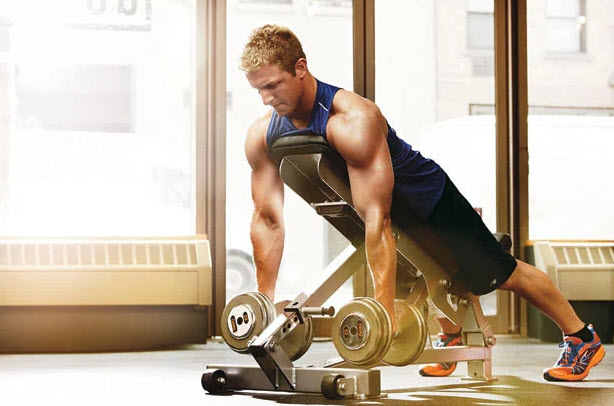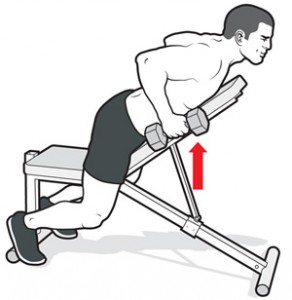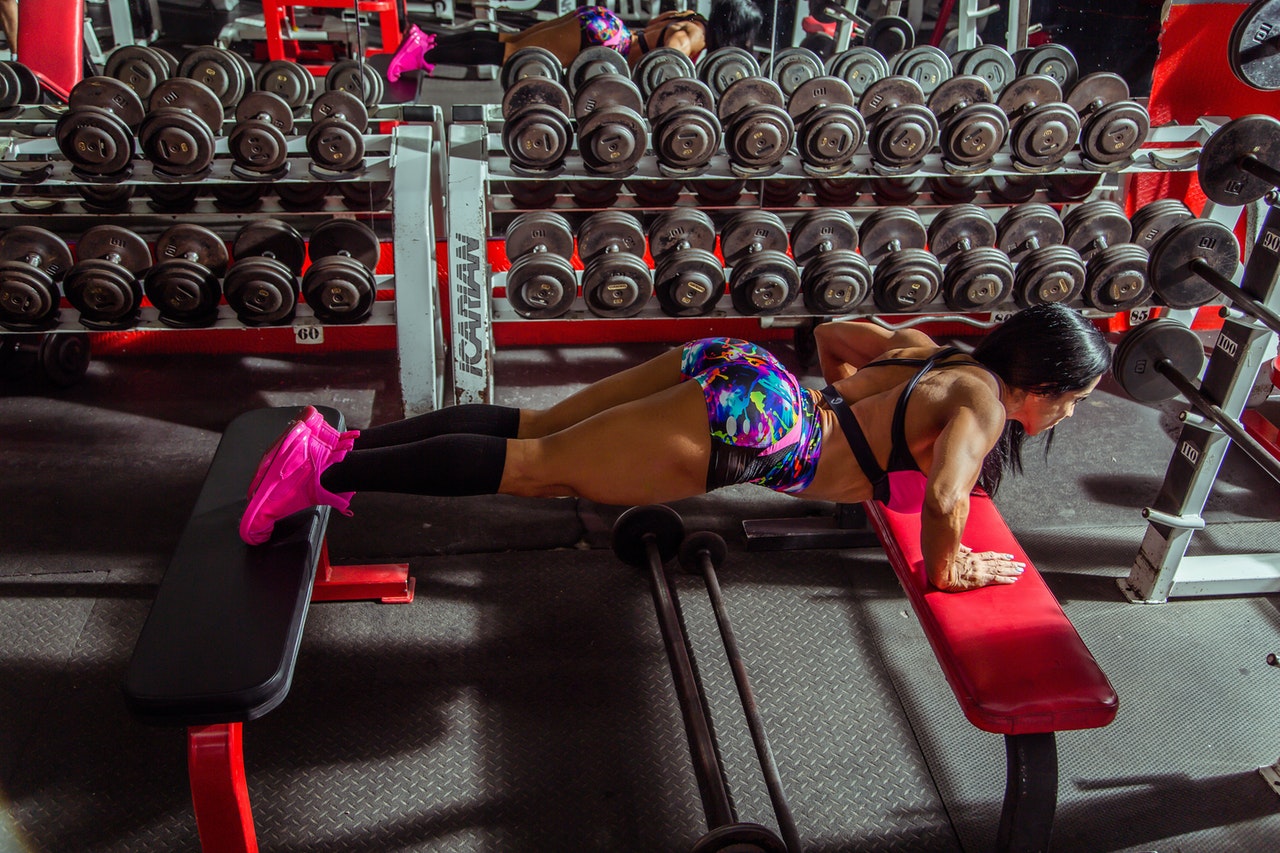Getting your body built at a specific point could be challenging for newbies. And some lifters recovering from back injuries may find a suitable exercise difficult to spot.
Row movements offer several variations for spine, lats, and general muscle training. And one of the best movements to begin your row sessions is an incline bench or chest supported routine.
In this guide, you’ll be getting complete details on how to use the chest-supported dumbbell row movement to capacity.

And if you’ve got other row variations in mind, this piece has you covered!
Besides providing essential information on how to get perfect chest support rows, there’s more!
Everything required to perform this exercise proper and get stronger form is available in this post. You can also leverage the massive list of variation routines if you’re planning to progress into other row movements.
Table of Contents
What is a Chest Supported Row?
Chest supported dumbbell rows, sometimes-called inclined rows is a movement that encourages a stronger build along the upper torso region.
It’s a movement functional only on an inclined bench when performing successive rows. The position provides ample comfort for your back than in a standing row position. It is a popular movement often performed by newbies to row routines.
But when it comes to getting gluteus and core regions worked, this position may not be ideal.
There are different variations to the row routine, and each has a specific build focus.
Who Should Do Chest Supported Rows?
People targeting upper back muscle development
The chest supported dumbbell row is an ideal routine to target back muscles. If you’re keen on a movement that focuses on shoulder, forearm, and upper torso muscles, this is an excellent choice.
Most of these muscles get worked at the same time in a similar manner to bent over row movements.

Exercise enthusiasts with lower back issues
Do you have a nagging lower back issue and don’t want to take time off the gym?
The chest supported row is a great routine is a top routine to keep you in form. You can still get muscles around your back worked, even when you’ve got some frail regions at the moment.
Newcomers to row movements
Newbies to row exercises can perform the incline bench movement to get better at other challenging routines. The major focus of this exercise is to familiarize newbies with row movements or help athletes in recovery.
Who Shouldn’t Try Chest Supported Rows?
People suffering from upper back pain
Someone recently coming off a lengthy injury layoff should consider if this is the right movement for their recovery. In most cases, people that cannot perform a bent over row should avoid this routine.
Trainers with already-built upper backs
If you’re a pro and already have a super-built back, this incline bench movement could be wasted on you.
Consider trying other advanced routines to maintain your form, instead of performing light incline bench movements.
Lifters with a history of upper back injury
If you’ve had to deal with an upper back injury in the past, it’s better to leave out chest supported row movements. The movement has an immense attention on muscles around your upper back more than any other region.
People with a long history of shoulder blades, deltoid muscles, and upper back injury could aggravate old wounds. So, it’s a smart option to avoid chest supported row movements, particularly with heavier dumbbells.
How to Do Chest Supported Rows Right
Get an incline bench with enough space to keep your chest region planted and in proper form
- The incline bench should be at 40 – 45 degrees
- Get two dumbbells and lean onto the incline bench. Your arms should hang down with both your palms facing one another.
- Squeeze shoulder blade together, driving elbows vertically, bringing dumbbells to your rib area
- Reverse move and repeat to complete each rep
How to Do Chest Supported Rows at Home Without a Gym Bench
If you can’t get a gym bench at home and need your shoulders and traps trained, there’s no hassle!
Rowing at home could be straightforward if you try out these steps:
- Get a wide bench or table capable of supporting your suspended body weight
- Place the bench at a 39 – 45 degree angle depending on your preference. But a higher angle is preferable.
- After placing at your desired degree of inclination, test if you can stretch out with your arms apart
- Get your dumbbells on each arm, and you’re ready
Muscles Worked
Biceps
Three muscles along the biceps, brachii, brachioradialis, and brachialis get loaded during chest rows.
The technique helps work muscles when you engage elbow flexing and rotate your forearms during reps. With this routine, you could get tighter biceps with proper form.
Lower back muscles and latissimus dorsi
Are you keen on a ripped V-shape? You’ve got to work your latissimus dorsi muscles.
The latissimus dorsi muscles are two fan-shaped muscles spanning your upper arms, lower back and mid-section. These muscles constitute the largest pulling force across your upper body.
Regular chest supported dumbbell rows provide improved pulling strength and power-up these muscles.

Rhomboids
The muscle group has a diamond shape and lies around your lower back. Rhomboids are minor and major in form and span from your spine to shoulder blade area.
Rhomboids help pull your shoulders back and aid stability during pushes and pulls. Working the rhomboids with chest rows provides ample resistance to tear, improved form, and better pulling force.
Trapezius muscles
Traps muscles look like a kite and stretch from your mid back out to your neck and shoulder region. The main function of trapezius muscles is to provide stability for your shoulder blades. Three fibers make up this muscle group, and chest rows work them all.
Chest rows target the stretch potential of these muscles, giving your shoulder blades more support as a result.
Benefits of Chest Supported Rows
Improved back strength and build
The chest supported row movement mainly targets back muscles, delivering better muscle resistance.
And if you’re looking to build a wider back, chest supported rows help maintain your form without hassle.
Comfortable routine
An incline bench is needed to get the right support for this row movement. Since the movement is performed in a resting position, you can leverage better rest without hassle.
Also, several forms of this exercise demand users work their muscles with an isometric hold. The bench provides massive support to work your lats more than ever with increased comfort.
Precise deadlift
More power stretching across your upper body makes it easier to get better lifting potential over time. And one of the best ways to get better upper body strength is with repeated chest supported dumbbell rows.
Range of motion boost
Boosting your range of motion for advanced exercise movements could be challenging. If you don’t practice right, there’s a risk of rupturing muscle tissue time and again.
The chest supported row movement provides ample support for exercise progression. So, if you’re searching for a top movement to help you gain more balance, consider performing chest supported rows.
Chest Supported Row Variations
5/5/15 Chest Supported Row
The set involves:
- Five (5) seconds isometric hold to squeeze lats region after every five (5) reps
- Fifteen (15) total reps, with three isometric holds in-between
Alternating Chest Supported Dumbbell Row
The variation involves letting one arm hang out while performing a row with your other arm. Alternating the rows between arms in each rep is a major component of this routine.
Iso-Hold, Alternating Chest Supported Row
The routine has similarities with alternating chest rows. But in this case, performers have to hold one dumbbell at their hip in each rep and exchange hands successively.
Iso-Hold, Pre-Exhaust Chest Supported Row
With an isometric hold for thirty seconds at your hip region before rowing, this is a latissumus dorsi focal variation. It helps work muscles more at the upper torso area based on its targeted loading potential.
Iso-Hold, Single Arm Chest Supported Row
In this variation, you have to perform an inclined hold of one dumbbell against your hip. When holding the dumbbell against your hip, engage full contraction, engaging reps using your other arm.
Rep Progression, Shrug Chest Supported Row
The movement follows this pattern:
One row – one shrug in successive additions till you get to five rows and five shrugs. The routine adapts several forms from Cory Gregory’s Reps Progression Technique.
Single Arm Chest Supported Row
The row movement involves wrapping your free hand around an inclined bench. One dumbbell goes into completing this movement.
When engaging this position, make sure you keep your chest planted on this pad. With this position, you can keep your torso from rotating and maintain proper form.
Chest Supported Row Alternatives
- High-Rep, Heavy Dumbbell Row
- Incline Bench Dumbbell Row
- Inverted Row
- Isometric Dumbbell Row
- Meadows Row
- Rack Row
- Seal Row
Common Errors to Avoid When Engaging Chest Supported Rows
Bending spine area
When you’re engaging this movement, it could be inimical to bend your spine upward. Consider keeping your torso flat on the incline bench to get better results.
Low and mid-row rocking
The incline bench needs to be at a stable point to avoid rocking which may set your stance off balance. When rocking takes place, the muscle groups on your upper torso may not get worked.
FAQs
What does Chest Supported Row work?
- Lower back and latissimus dorsi muscles
- Rhomboids
- Trapezius muscles
- Biceps
How do you do chest supported rows at home?
- With a bench or table placed at a secure, inclined angle strong enough to support your body weight
- Lean onto the bench with your chest first
- Engage any chest supported row variation you fancy
What is a chest supported dumbbell row?
A chest supported dumbbell row is a beginner or recovery-level exercise movement that targets upper back muscles.
Last Row
Most people find the hip hinge – flat back position of a bent row challenging. To avoid an underwhelming experience with advanced row movements, try out the incline bench set.
Don’t want to risk aggravating an old injury? It’s a great routine to try out. It has a strong focus on upper torso build and makes your lats more durable.
Besides avoiding risk, the chest row movement is a perfect exercise performed by newbies. People planning to get to the next step in-gym take time with this routine.
If you’re planning to engage a movement with minimal range of motion, this is a perfect routine.
Engage what the routine has to offer, and get stronger upper body muscles without hassle!

I started my sporting career at the age of 3 in the preparation of ice hockey. I spent sixteen years playing ice hockey, and I remember the summer preparations today. What are my passions? It is still fitness training, all kinds of workouts and the most important is a healthy lifestyle. You can’t just do a workout without the right way of life. You need to stay curious and listen to your body.


